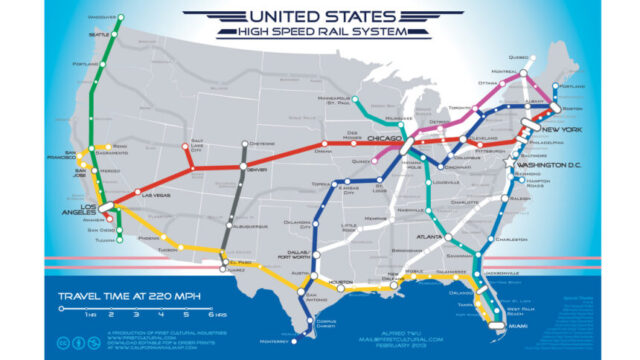US Attempts to Catch Up with High-Speed Rail Initiatives
Despite being a nation of over 340 million people, 71 interstate highways, and more than 5,000 airports, the United States has yet to establish a high-speed rail network (HSR). However, with two major projects currently underway, questions arise regarding whether America can finally match the high-speed rail systems prevalent in countries like China, Japan, and various European nations.
Current Projects and Challenges
Rick Harnish, from the High Speed Rail Alliance, emphasizes the significance of the ongoing projects. “The first project connects San Francisco to Los Angeles, which presents substantial challenges due to the mountainous terrain of California,” he notes. “The second, which runs from Las Vegas to Los Angeles, is less complex as it traverses flat ground.”
In addition to these projects, proposals are in place for a rail corridor stretching from Portland, Oregon, to Seattle, Washington, and on to Vancouver, Canada, along with another line between Dallas and Houston. However, concerns linger over the pace of development for the Portland-Seattle project, with further uncertainty clouding the Texas corridor following the cancellation of a significant federal grant.
Comparison with Global HSR Networks
In stark contrast to the United States, China’s high-speed rail network is projected to stretch over 50,000 km (approximately 31,000 miles) this year. In Europe, the combined length of high-speed rail lines reaches 8,556 km, led by Spain’s 3,190 km. The UK currently has High Speed 1, which links London to the Channel Tunnel, and is developing High Speed 2, connecting London to Birmingham, despite ongoing funding challenges.
| Country/Region | Length of HSR (km) |
|---|---|
| China | 50,000+ |
| Europe | 8,556 |
| Spain | 3,190 |
| UK | 68 (HS1) |
Barriers to Development in the US
According to rail industry journalist Will Doig, the slow progress in establishing HSR in the United States can be attributed to a widespread car culture and lack of public support. Many individuals either do not see the necessity for high-speed rail or oppose it in their local areas. Additionally, governmental support for rail projects has notably diminished in recent times.
Further complicating the landscape, Stephen Gardner, the head of Amtrak, recently stepped down amid reports of pressure from the White House. Currently, Amtrak does not operate any high-speed trains, although it plans to introduce 28 new Acela trains with a speed of 160 mph on the Northeast Corridor soon. Unfortunately, only a small portion of the existing railways supports such speeds.
Future Outlook
As the US seeks to develop its high-speed rail infrastructure, experts like Harnish argue that federal government involvement is crucial. However, recent actions indicate that the current administration is hesitant to allocate funds for HSR projects, especially after declaring the proposed Dallas-Houston line a “waste of taxpayers’ money.”
Despite these challenges, Doig expresses a hope for potential collaboration with China in building a more robust rail system in the US, although he acknowledges the political difficulties surrounding such a partnership.
Ultimately, if the United States wishes to make significant strides in high-speed rail development, it will need to foster a cultural shift towards embracing public transportation and reevaluate its transportation priorities for the future.














